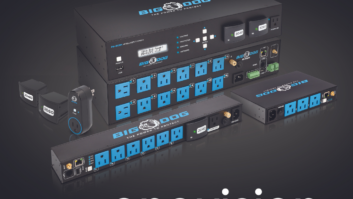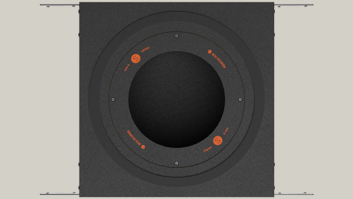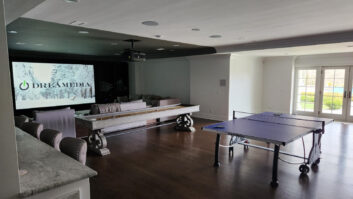If youre like a lot of other custom installers, you probably spend a fair amount of time thinking about what separates your custom business from giant electronics retailers.
Its a fair question, after all.
You dont need to be clairvoyant to see that the line between big-box retailers and custom installers appears to grow fainter by the day. Electronics warehouses sell much higher quality equipment than in times past, and they even offer installationsometimes free of charge.
So, how do you compete with them? Theres no way that you can sell as much product as they do, and your advertising budget compared with theirs is nothing. Are people going to believe that your installation is really that much better? Is it worth the extra cost?
Fortunately, the line is not as frail as you might think. In fact, its more like a gap or a chasm if you look at it from a slightly different perspective. Forget playing the sales game with a mega-corporation, because theyll always win. You dont have to outsell them to distance yourself from them.
You dont do what they do. You dont just sell boxes and install them. You sell experiences. You know the secret of what people truly desire in home entertainment. It isnt about cool equipment with lots of buttons, connectors, and flashy lights. Its about a visual, aural, and emotional experience that is unparalleled in the world, all placed reassuringly under control at their fingertips.
You may wonder what on earth you can do to deliver this kind of experience to a client. The answer is so simple that many people have passed over it unwittingly. An experience comes from a room and equipment that are so seamlessly integrated and work in such harmony that they become invisible. That is the key.
You must consider both the room and the equipment to be pieces of a much larger puzzlethe home entertainment experience. Take, for example, a flat, white projection screen. It may be of exceptional quality, affordable, and high margin. In a dedicated home theater, it would produce a dazzling picture with incredible reality. Put that same screen in a media room with glossy white walls and lots of ambient light, however, and youll be lucky to see an image at all. By the same token, a high-gain screen may dazzle viewers in a bright room, but lack sufficient horizontal or vertical viewing angles to cover everyone in a dedicated home theater.
The same principle holds true for speakers. A wide dispersion speaker may cover all of the rows beautifully in a home theater, where the wall surfaces are treated to control reflections. But that same speaker would instantly drown in a sea of reflections if it were put in a cavernous media room with lots of wood paneling and glass doors. In that room, you should use a speaker that focuses the sound at the listeners to minimize reflections. See how the room and equipment must work together?
Grand theory and rhetoric are well and good, but the real world is all about application. When the time comes to pull out the DeWalt and start drilling holes and driving screws, you have to know what youre doing. Creating a home entertainment experience is not as hard as you might think; you just need a firm handle on the process.
The Discovery Process. If you need a room that will transport your client wherever he or she wants to go, then you first have to find out where that is. This part of the process is called discovery, and how you do it can separate you from the box movers right off the bat. Discovery for them is as simple as finding out how much a client wants to spend and selecting a group of boxes from those that they overstocked that add up to the right number on the bottom line.
You, on the other hand, should take discovery very seriously, because here you will find out exactly what the client wants. Here you will find out how the client is going to judge whether or not you did a good job when all is said and done. If the client wants a media room, dont insist on a studio mix room. If the client wants a game room, dont force it to be a home theater.
Design Time. After discovery comes design. You work with the client, the architect, and even the interior designer to create a feel for the room. You decide, in general, which way to orient the room, where to put equipment, where to put the screen, where to put the seats, how to make everything look the way the client wants it to look, and how the client is going to control all of the operations of the room.
Engineering Essentials. Engineering follows, and here you must put pen to paper no matter how painful it may be. Simply designing a room isnt enough, even though most custom installers stop there. Engineering is more than placing things around the room. You think you want four rows with a front projection system where the projector is in a room behind the theater? Wonderful idea, except the ceiling is only nine feet. If you actually sit down and draw a plan with numbers and sightlines, youd see that peoples heads are going to block either the image or the sightlines. Lose a row or make the ceiling higher and everything works.
Other things that you need to analyze during engineering include subtended viewing angles, projector light output, projector throw angle, screen gain, speaker subtended listening angles, speaker output, seat locations, reflection locations, reflection decay time, room resonances, interior/exterior sound isolation, background noise, and control interfaces between the devices. Dont just assume that these things are going to be magically OK, or that youll work them out on site. It doesnt work. Youll wind up with major compromises that were totally avoidablecompromises that ruin the experience.
Installation. First, obey codes. If you dont know whether what youre doing is legal or not, ask around. Dont just assume that it will never be a problem. Second, do neat work in addition to good work. Insist on using dedicated equipment racks in a separate room with full 360-degree access. Manage wires from one end to the other (even in places that no one will ever see), and clearly label both ends with each wires origin and destination. What would a client rather have, an installation that looks like the domicile of a small furry rodent, or one where you have to look twice to see any wires? Never underestimate the psychological impact that a clean installation has on a client.
Calibration. The next step is the most important of all. How long do you think it should take to calibrate the audio and video systems in a home theater? An hour? Several hours? A whole afternoon? Try three days, and thats assuming nothing goes wrong. Audio calibration alone involves 80 different tests and configurations that have to be performed, and theres video calibration on top of that. Do you ever wonder why your systems lack that extra punch that makes the whole entertainment experience palpable? The reason may be that youre not tuning your systems to perform at their optimal level.
Calibration is your time with a system to work out all the bugs. When youre satisfied that everything is as good as it can be, bring in the client. Give him or her a brief overview of what youve done, and then sit down for the next step.
Client Demo and Training. Play material that you know will show off the systems capabilities. Dont just use loud bombastic concerts and action movies.
Subtlety is just as important as brute force. You want to hear dialog perfectly whether the actors are whispering to each other in hiding or yelling at the tops of their lungs as they dangle out of a jetliner at 10,000 feet. After the demo, walk the client through the processes that he or she will be using to control the system. Perform some of the most common operations, and then have the client do them while you watch. Turn the system on and off. Play a movie. Watch TV. Cue a game. Dont leave until the client is thoroughly comfortable with his or her ability to access the features of the system.
Followup. The final step is to schedule a time for follow up with the client so he or she doesnt feel like youre going to take the money and run. Follow-up may be a week after the initial training day, or it may be a month. The amount of time will be different with different clients. Tell the client to make a list of all his or her questions about the system and any items that requires additional work. Youll take care of it all when you come back.
Put all these steps together, and you will be on your way to selling experiences instead of boxes. Things may not go smoothly at first, but dont be discouraged. It takes time to work out all the little details of a complex process. Just take calibration as an example.
The thing to keep in mindthe thing that separates you from the big-box guysis that you see the whole picture. You know the room is just as important as the gear. You know that the right gear for one room is the wrong gear for another. You know to design a video system to match a rooms optical environment. You know how to predict acoustic problems and devise solutions. You look at home entertainment an entirely different way, and your way, if you can make your clients see it, ensures that they will get the maximum return on their investment. They may have thought home entertainment was about equipment, but what you can give them is the experience of their lives.
Anthony Grimani ([email protected]) is president of Performance Media Industries, a California-based acoustical engineering firm specializing in home theater design and calibration. Chase Walton ([email protected]) contributed to this article.





